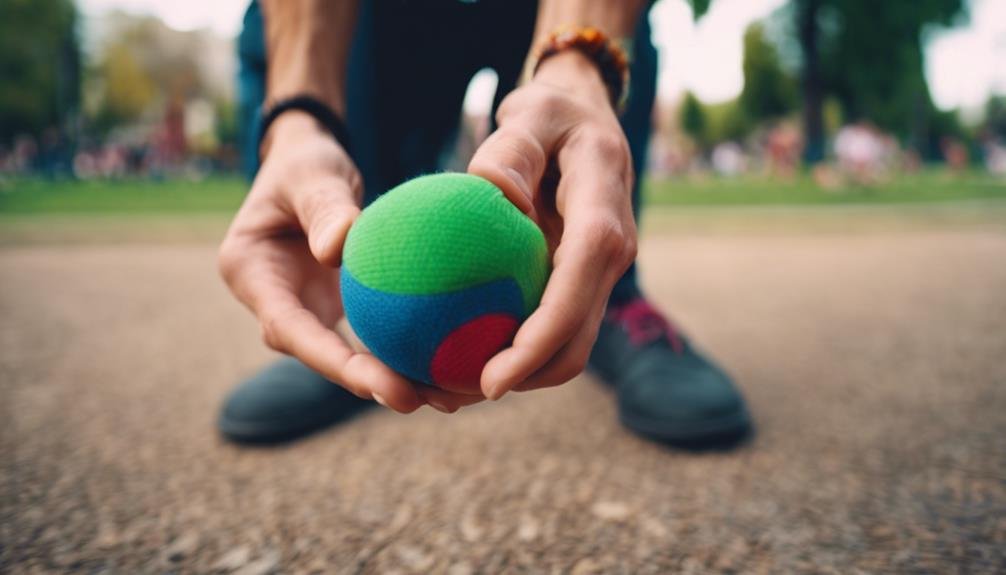When starting with a hacky sack, choosing the best one for beginners can significantly affect how quickly you progress. A beginner should look for a model that’s forgiving and easy to control, like the Dragonfly Footbags’ ChainmailPink. These footbags are known for their soft texture and moderate weight, which help develop your kicking techniques and control. While these qualities are essential, there’s more to ponder, such as the material and size that could further enhance your initial experience. What might those be, and how could they affect your learning curve? Let’s explore these aspects together.
Key Takeaways
- Opt for footbags with soft materials like ultra suede or poly-fleece for comfort and easier handling.
- Choose a sand-filled hacky sack to enhance control with its predictable behavior and lower center of gravity.
- Select beginner-friendly footbags that are larger and softer, facilitating easier learning and control.
- Consider purchasing from Dragonfly Footbags, known for their quality and beginner-friendly options.
- Practice with lighter footbags initially to master control and basic stalling techniques.
Choosing Your First Hacky Sack

When selecting your first hacky sack, choose a soft, user-friendly material like ultra suede or poly-fleece for better control. These materials are gentle on your feet, making it easier to handle the hacky sack without slipping away. They’re ideal for beginners just getting the hang of the game.
You’ll also want to consider a sand-filled hacky sack. The added weight of the sand helps the sack maintain a lower center of gravity. This feature slows the sack’s flight, giving you more time to react and correctly position your foot. The sand filling also contributes to a more predictable behavior when kicked, which is important when learning the proper techniques.
Furthermore, the sand in the footbag molds to the shape of your foot, providing a more comfortable and controlled touch. This adaptation enhances your ability to perform stalls and other tricks requiring the sack to rest on your foot or other body parts momentarily. Remember, the goal is to build your skills gradually, and a sand-filled hacky sack can be a perfect tool to help you progress confidently and enjoyably.
Understanding Footbag Materials
Understanding the variety of materials used in footbag construction is essential as you select your ideal hacky sack. Synthetic materials like ultra suede, poly-fleece, and crushed panne fabric are commonly used. Each material offers a distinct touch and durability, influencing the footbag’s behavior during play.
For instance, synthetic suedes are celebrated for their softness and resilience, making them a favorite among beginners and freestyle enthusiasts. These materials guarantee that the footbag isn’t only comfortable to kick and withstands the rigors of frequent use. Additionally, the panel design, often involving multiple panels, plays an important role in a footbag’s performance. Multi-panel designs enhance the footbag’s roundness and predictability in flight, which is essential when starting or aiming to improve your freestyle skills.
Additionally, you might encounter crocheted footbags made from rayon or cotton. These vary in size and density, offering a unique feel and slower play, which might be helpful as you’re learning. Elite-level freestylers often lean towards materials like facile for their footbags due to the buttery feel, enhancing their ability to control the sack precisely.
Types of Footbags Explained

Now that you’re familiar with footbag materials let’s explore the types available and how they cater to various playing styles. Choosing the right hacky sack type is essential as you start your journey in this playful sport.
- Freestyle Footbags: These are designed for individuals interested in performing stalls and tricks. Their structure allows for excellent control and maneuverability, making them a top choice for mastering complex moves.
- Circle Footbags: Ideal for group play and circle games, these hacky sacks promote interaction and teamwork. They’re great for passing around in large groups and enhancing social play and cooperative skills.
- All-around Footbags: If you’re not sure which playing style suits you best or you enjoy a variety of playing methods, these footbags offer versatility. They cater to different preferences, allowing you to experiment with casual kicks and more structured tricks.
- Beginner Footbags: Specifically tailored for newcomers, these footbags help you learn basic kicks and control techniques. They’re larger and often softer, easing your entry into the game with more forgiving handling characteristics.
Each hacky sack type serves a unique purpose, ensuring a perfect match for every player’s needs.
Importance of Footbag Weight
The weight of your footbag greatly impacts how it performs during play, influencing everything from control to the ability to execute advanced tricks. As you explore the world of hacky sacks, it’s important to understand how different weights influence your game.
If you’re starting, choosing a lighter footbag is your best bet. These are easier to control and manipulate, making keeping the hacky sack in the air less challenging as you practice your kicks and passes. This initial ease of use helps build confidence and essential skills without frustration.
However, as you become more comfortable and your skills advance, a heavier footbag might be worth considering. The added weight provides greater stability and consistency, making it ideal for refining your technique and tackling more complex maneuvers. This switch is significant as it aids in developing a deeper understanding of how force and precision play into hacky sack dynamics.
Balancing and Stalling Basics

To master the hacky sack game, you’ll need to start with the basics of balancing and stalling, essential skills for controlling the footbag. Balancing involves keeping the footbag on your foot with controlled movements. Stalling is when you momentarily halt the footbag’s movement on a specific body part, such as your foot or knee. These techniques are foundational for any beginner.
Here are the steps to get started:
- Toe Stall: Begin by gently tossing the footbag onto your toe. Keep your foot horizontal and try to make the footbag land softly. This makes it easier to stall and maintain balance.
- Inside Stall: Turn your foot inward and catch the footbag on the inside of your foot. Keep your knee slightly bent.
- Timing Practice: Throw the footbag up and try to stall it as it comes down. Adjust your foot or knee position to cushion the footbag’s descent.
- Consistent Practice: The more you practice, the better your sense of timing and touch will become, making it easier to execute smooth adjustments and stalls.
As you develop these skills, you’ll find it easier to stall and control the footbag, paving the way for more advanced maneuvers.
Tips for Footbag Maintenance
Regularly checking your footbag’s stitching and seams can help prevent unexpected wear and tear. This is particularly important for freestyle footbags, which often endure more dynamic and varied impacts than standard models. If you notice any fraying or loose threads, it’s time for a repair or replacement to keep your game smooth.
You’ll also want to keep your footbag clean. Wipe the surface with a damp cloth or, if necessary, a mild soap. This keeps it looking fresh and prevents dirt from affecting its performance. Make sure it’s completely dry before you store it.
Speaking of storage, find a cool, dry place away from direct sunlight. Excessive moisture can lead to mold, and too much heat might warp its shape, affecting play. To maintain consistent performance, rotate the fillers inside your footbag occasionally. This helps redistribute them evenly, maintaining a consistent weight distribution for executing those beginner moves smoothly.
Lastly, steer clear of harsh chemicals and extreme temperatures. Both can degrade the materials of your footbag, shortening its lifespan drastically. With these maintenance tips, you’ll keep your footbag in top shape, ready for every kick.
Advancing Beyond Beginner Tricks

Once you’ve mastered the basics, it’s time to tackle more complex combos like toe knee and rainbow to boost your hacky sack skills. Advancing in hacky sack isn’t just about keeping the sack off the ground; it involves elevating your freestyle play with intricate patterns and combinations. Focusing on more challenging techniques will enhance your coordination and ability to perform under pressure.
To effectively improve and add complexity to your game, consider these steps:
- Practice stalling: Move from a toe stall to a knee stall. This will improve your balance and precision.
- Master Doubles: Perform two kicks before the sack touches the ground. It requires quick reflexes and sharpens your response time.
- Integrate Combos: Combine different moves like the toe knee and rainbow. This develops your creative thinking and freestyle routine.
- Repeat Patterns: Regular repetition of these combos will build muscle memory and boost your confidence during freestyle play.
As you integrate these techniques, you’ll notice a significant improvement in your gameplay, preparing you for even more advanced freestyle tricks. Keep pushing your limits, and you’ll see how rewarding hacky sacks can be.
Popular Beginner Footbags Reviewed
Now that you’re familiar with advancing your skills let’s explore some of the top beginner footbags on the market, starting with Dragonfly Footbags. Dragonfly offers a variety of beginner-friendly options, ensuring you can find the perfect hacky sack to begin your journey.
The ChainmailPink / Light Pink / White footbag stands out among their popular choices. It’s stylish and crafted with soft, durable materials that help you control your kicks more effectively.
Another excellent choice for novices is the Dragonfly Footbags Sand-Filled Footbag. This hacky sack is specifically designed to accommodate your growing skills. The sand filling gives it a moderate weight, making it easier to manage and predict its movements during play. This feature is important as you practice your fundamental kicks and tricks.
Understanding the features and fillings of these beginner footbags is important. Softer materials and appropriate filling contribute significantly to a smoother learning curve. As you start your footbag journey, choosing the right hacky sack, like those from Dragonfly, can make a big difference in how quickly and effectively you progress in the sport.
Where to Buy Your Hacky Sack

If you’re ready to purchase your first hacky sack, Dragonfly Footbags offers a variety of beginner-friendly options online. Founded in 1999 by John Webber, Dragonfly has been the go-to source for quality hacky sacks, combining years of expertise with a commitment to performance and durability. Whether in the US or abroad, you can easily find a footbag that suits your needs, as they’ve successfully shipped to 94 countries and every US state.
Here’s why you should consider purchasing from Dragonfly Footbags:
- Experience: With over two decades in the business, their knowledge in crafting high-quality footbags is unparalleled.
- Quality: Each hand-made footbag ensures you receive a product built to last and perform well.
- Variety: They offer a wide range of footbags specifically tailored for beginners, enhancing your learning curve.
- Accessibility: You can order your hacky sack online and deliver it to your doorstep, no matter where you are.
Conclusion
You’re on the right track, starting your hacky sack journey with the right footbag. Opt for a soft, sand-filled option like those from Dragonfly Footbags to ease handling and boost your skills.
Practice the basics and maintain your sack, and you’ll be able to advance to more complex tricks. Explore the range of beginner-friendly footbags and find your perfect match online or in specialty stores.
Kick off your fun and skillful adventure in the hacky sack with confidence!
FAQs
What makes Dragonfly Footbags’ ChainmailPink ideal for beginners?
Dragonfly Footbags’ ChainmailPink is perfect for beginners due to its forgiving soft texture and moderate weight, facilitating easier control and skill development. The sand filling enhances predictability and stability, crucial for honing basic techniques like kicks and stalls.
Why is it important to choose a soft material like ultra suede or poly-fleece for a beginner hacky sack?
Soft materials like ultra suede or poly-fleece ensure comfort during play and make it easier to handle the hacky sack without slipping. These materials are gentle on the feet, ideal for beginners still mastering the game’s fundamentals.
What role does footbag weight play in a beginner’s learning curve?
Lighter footbags are recommended for beginners as they are easier to control and manipulate, building confidence and essential skills without frustration. However, as skills advance, transitioning to heavier footbags provides greater stability and consistency, refining technique for more complex maneuvers.

